Urban rooftops are undergoing a green renaissance as rooftop garden ideas blend design ingenuity with sustainability. From versatile container planters fashioned from repurposed buckets to extensive sedum mats that insulate buildings and reduce heat islands, these innovative rooftop garden ideas expand living landscapes vertically. Pioneers of urban wild gardening advocate using native, wind-tolerant plants in loose clusters to create self-regulating ecosystems that support pollinators and encourage biodiversity. Incorporating vertical wall gardens, water-harvesting systems, and modular planters transforms bare roof decks into multifunctional retreats that offer fresh food, calming ambiance, and energy savings. Whether you dream of a lush herb spiral or a fragrant lounge area beneath climbing vines, these rooftop garden ideas invite you to elevate your space with practical, nature-driven solutions.
1. Container Planters for a Versatile Rooftop Garden

A flexible way to bring greenery to any flat surface is through container planters, which make adapting a rooftop garden simple and accessible. Container gardens can be crafted from repurposed receptacles such as children's wading pools, sturdy plastic buckets, or even recycled wooden crates, all fitted with drainage holes to prevent waterlogging. This technique allows you to rearrange plants seasonally, rotating sunny and shade-loving species without permanent installation. Lightweight pots reduce structural load and can be treated with sealant for durability against weather. Combining containers of varying sizes and shapes also creates dynamic visual interest, while modularity lets you expand your rooftop garden as your collection grows.
2. Implementing Extensive Sedum Green Roof for Your Rooftop Garden
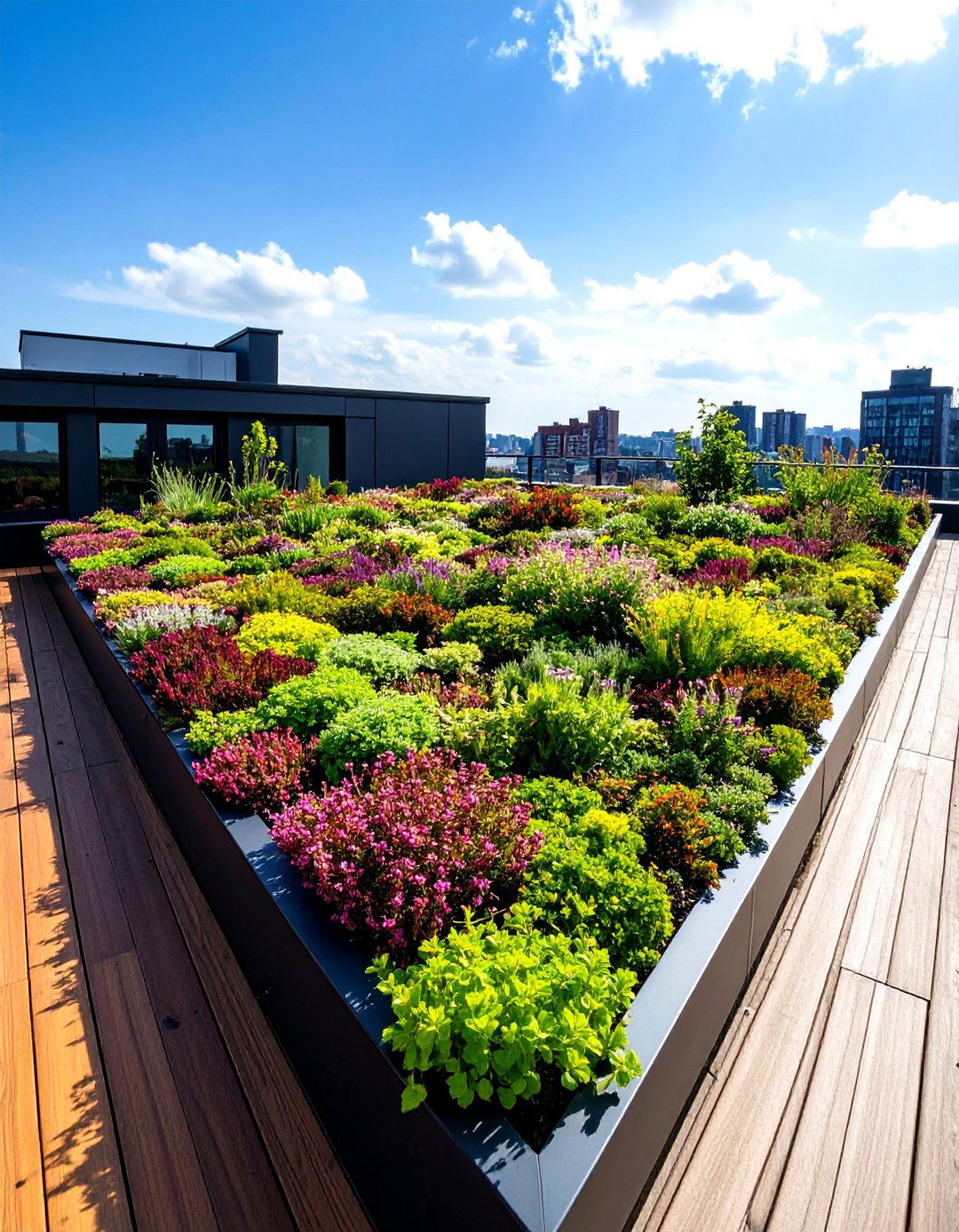
The implementation of extensive sedum green roof systems offers a lightweight, self-sustaining approach that enhances a rooftop garden’s ecological benefits. Extensive green roofs typically have a substrate depth between 4 and 15 cm and can weigh as little as 45 kg per square meter when planted with sedum mats, making them suitable for retrofit projects on existing rooftops. Sedum species thrive in shallow, free-draining substrates and tolerate heat, wind and drought, reducing maintenance needs over time. These living roofs absorb rainfall, improve building insulation, and support urban biodiversity by providing habitats for insects, birds, and beneficial microorganisms. Adopting this green roof style transforms bare rooftops into vibrant ecological assets.
3. Raised Beds to Elevate Your Rooftop Garden

An effective way to structure a rooftop garden is through raised garden beds, which provide depth, drainage and organization for diverse plantings. Raised beds can be constructed from rot-resistant lumber, metal containers, or concrete blocks, filled with lightweight potting mix to reduce load while offering 20–30 cm of rooting depth. Incorporating features like drip irrigation and fabric liners helps maintain moisture without leaking onto the rooftop below. Raised beds also define distinct planting areas for flowers, vegetables, or shrubs, and can be arranged in patterns that maximize sunlight exposure. With solid boundaries, these beds simplify soil management, weed control, and seasonal crop rotation in any rooftop garden setting.
4. Vertical Wall Gardens to Maximize Rooftop Garden Space
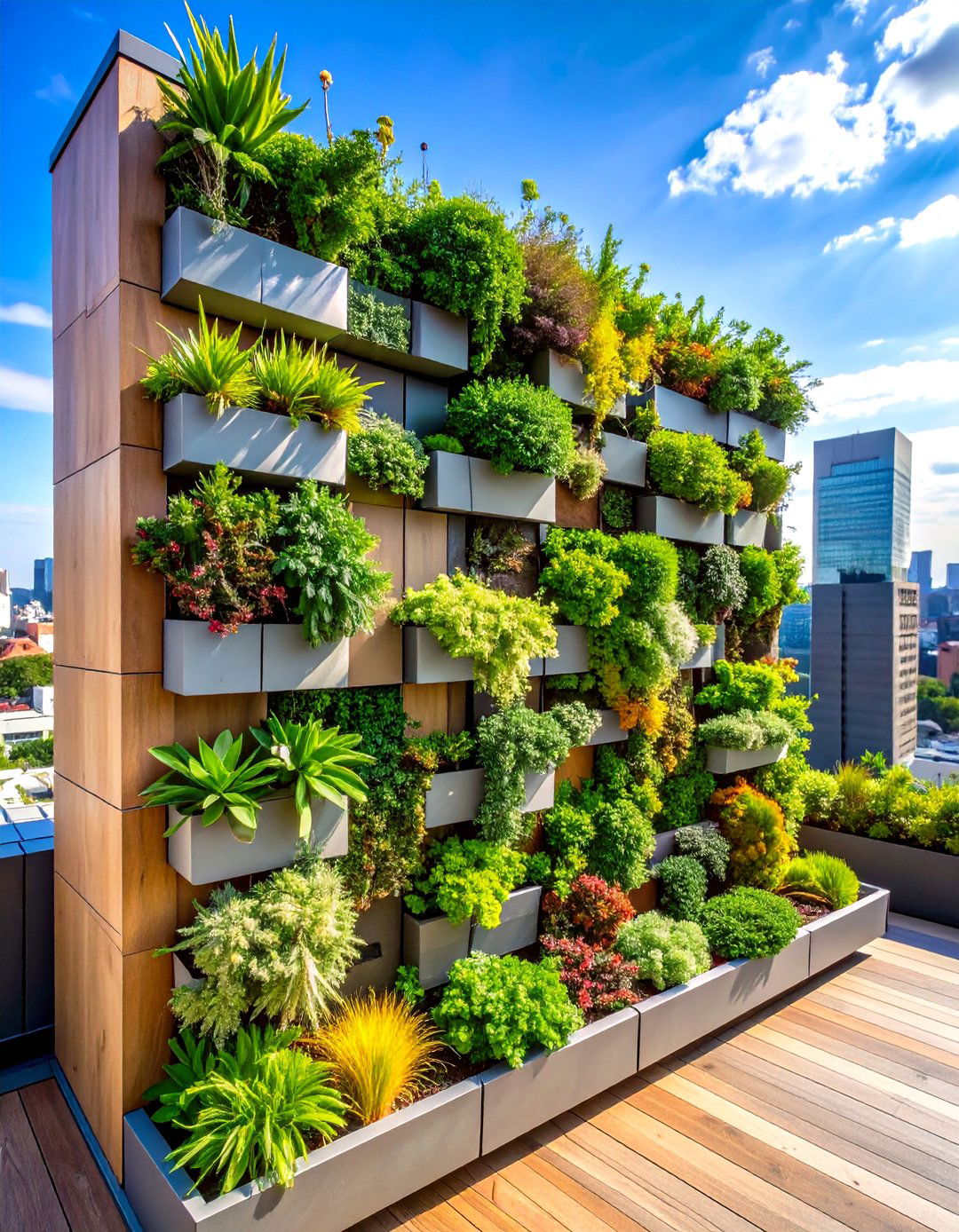
Vertical wall gardens bring lush greenery to otherwise bare walls, maximizing living space in a rooftop garden without using valuable floor area. Modular systems like pockets, hanging pots, or trellises can support climbing plants such as ivy, jasmine, or succulents, while a reliable irrigation system keeps the media evenly moist. Azure Farm’s designs emphasize creative use of containers at varying heights to add texture and color, transforming walls into vibrant plant mosaics that thrive in urban environments. Vertical gardens also serve as natural privacy screens and sound barriers, enhancing both the visual and acoustic comfort of your rooftop retreat.
5. Herb Spiral Planters for an Aromatic Rooftop Garden
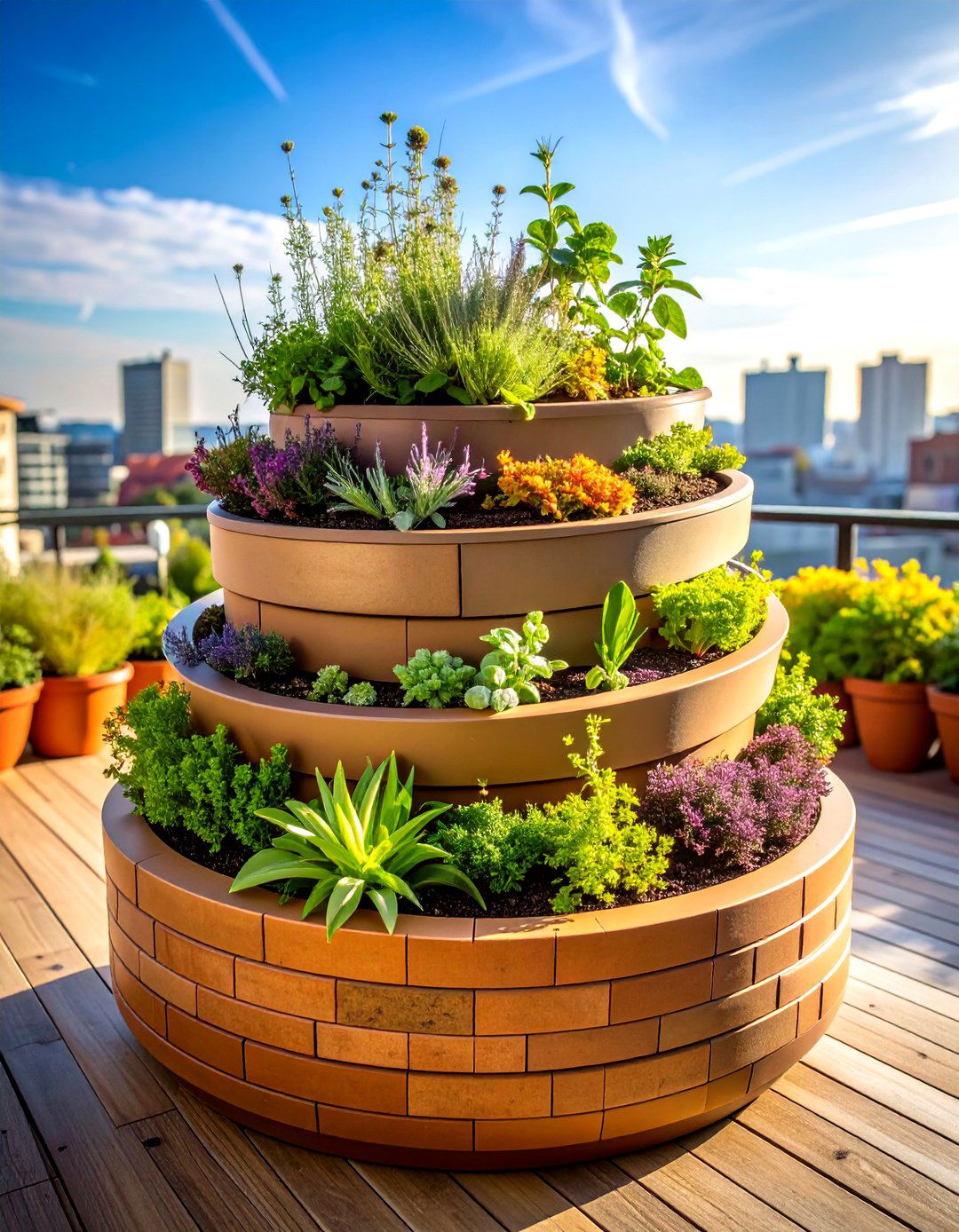
An herb spiral planter is a permaculture-inspired structure that optimizes microclimates within a compact footprint to support diverse culinary herbs in a rooftop garden setting. The spiral’s raised tiers create drier zones at the top for heat-loving thyme and rosemary and moister sections at the base for parsley and mint, ensuring each species thrives. Built from materials like bricks, stones or block, herb spirals make efficient use of space while creating an eye-catching focal point. Their self-draining design reduces watering needs, and the continuous slope encourages water distribution, helping rooftop gardeners achieve abundant, healthy herb harvests year-round with minimal maintenance.
6. Succulent Rock Gardens to Add Texture to a Rooftop Garden
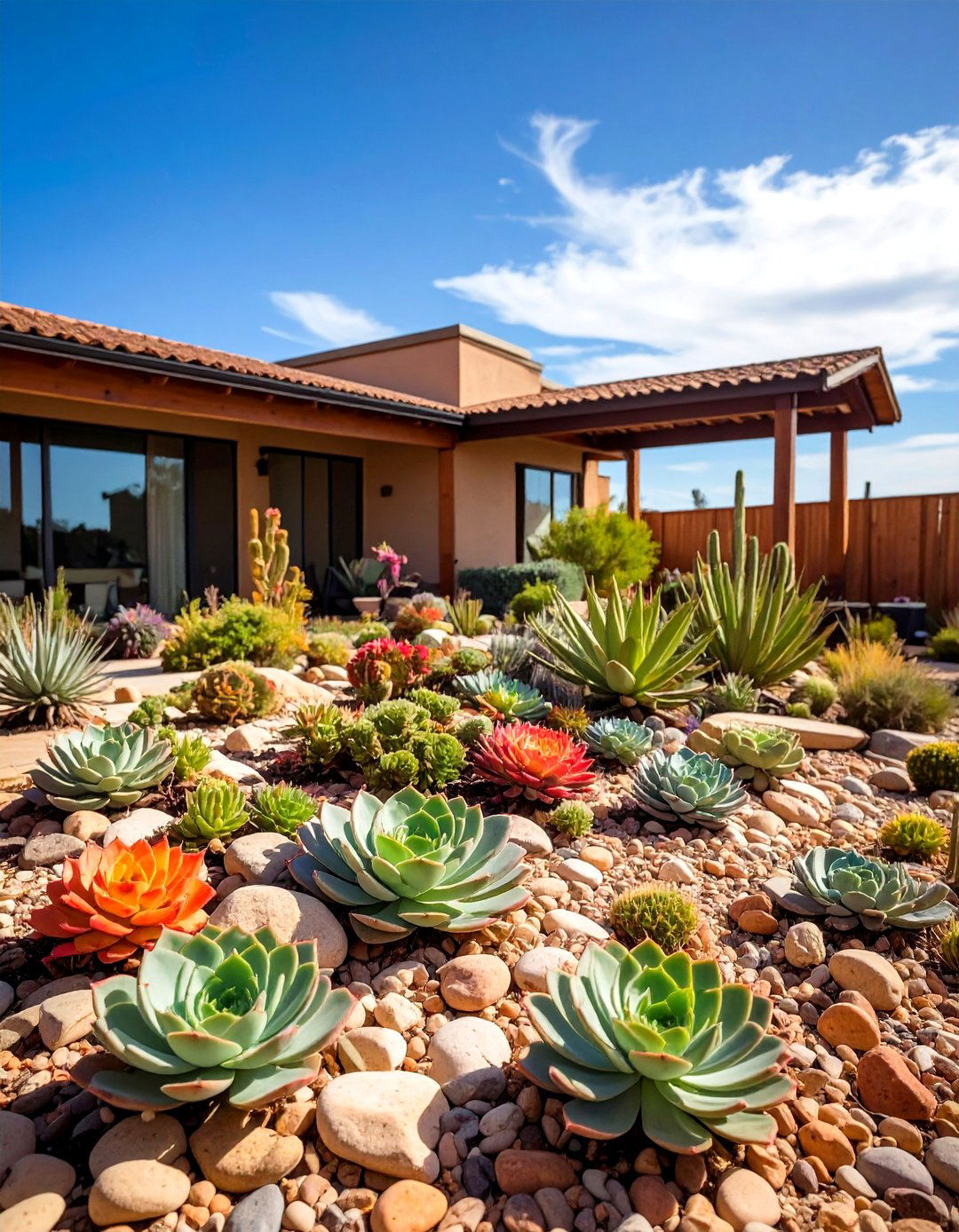
A succulent rock garden blends hardy succulents with pebbles and stones to create a low-maintenance, visually striking rooftop garden feature. Rocks provide drainage and heat retention, while drought-tolerant succulents such as sedums, echeverias and semps thrive in shallow soils with minimal watering. By planting at varying levels and incorporating coarse gravel pathways, you add depth and texture, mimicking natural arid landscapes. This design demands little care beyond occasional watering and ensures durability under harsh sun and wind conditions. Integrating succulents into a rooftop garden not only conserves water, but also supports fire-resistant planting strategies in vulnerable regions. Selecting succulents with varying colors and leaf textures enhances visual appeal, making the rooftop garden both practical and artistically dynamic.
7. Creating a Mixed-Use Lounge-Rooftop Garden Blend

A mixed-use rooftop garden seamlessly blends green plantings with seating, dining and play areas to create a multifunctional outdoor living space. On Manhattan’s condo rooftop, a 70 × 100 ft garden includes container plantings, raised beds, outdoor furniture, and barbecue grills, inviting residents to dine and socialize amid lush greenery. Strategically placed potted trees and privacy screens define zones for relaxation, while weather-resistant seating invites lingering conversations. Integrating flexible furnishings like foldable tables and modular benches ensures the rooftop garden adapts to changing events or seasons. This approach transforms bare roof decks into vibrant community spaces, encouraging social interaction around thriving plant life, and maximizing utility above busy city streets.
8. Pergola-Climbing Vines in Your Rooftop Garden
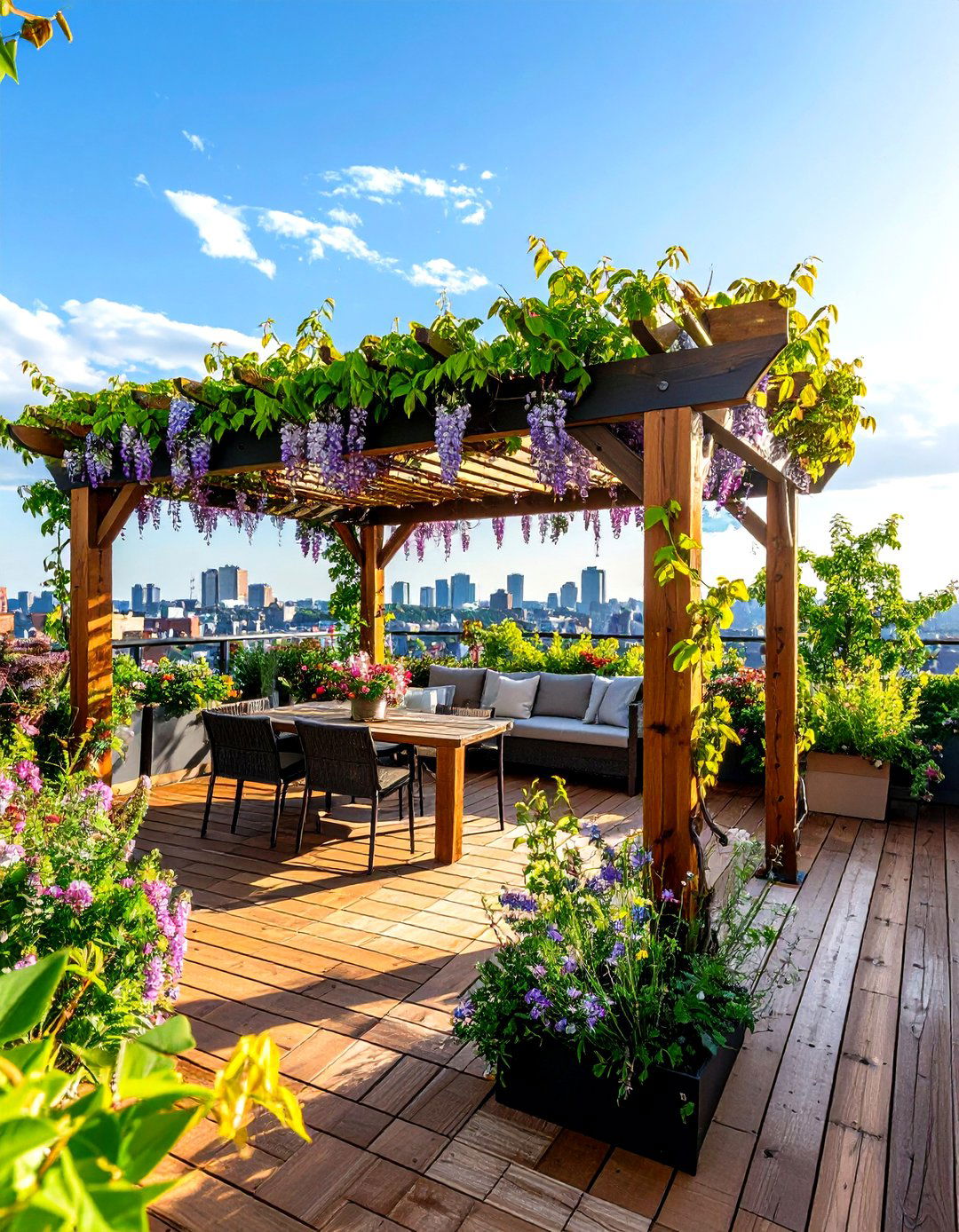
Climbing vines on pergolas create natural shade and vertical interest in a rooftop garden, while filtering wind and sun. Select Mediterranean vines like wisteria, clematis, or hardy honeysuckle that tolerate heat and windy conditions; these integrate seamlessly with pergola structures and develop fragrant, cascading blooms. Installing a sturdy pergola frame and training vines early in spring ensures rapid coverage and shade by summer. Pairing vines with ground-level plantings of materials featuring small leaves, such as lavender or santolina, reduces wind resistance and prevents damage. Over time, this living canopy offers a cool retreat for dining or relaxation, enhancing both comfort and aesthetics in any rooftop garden.
9. Edible Vegetable and Herb Gardens on Rooftop Garden Terraces
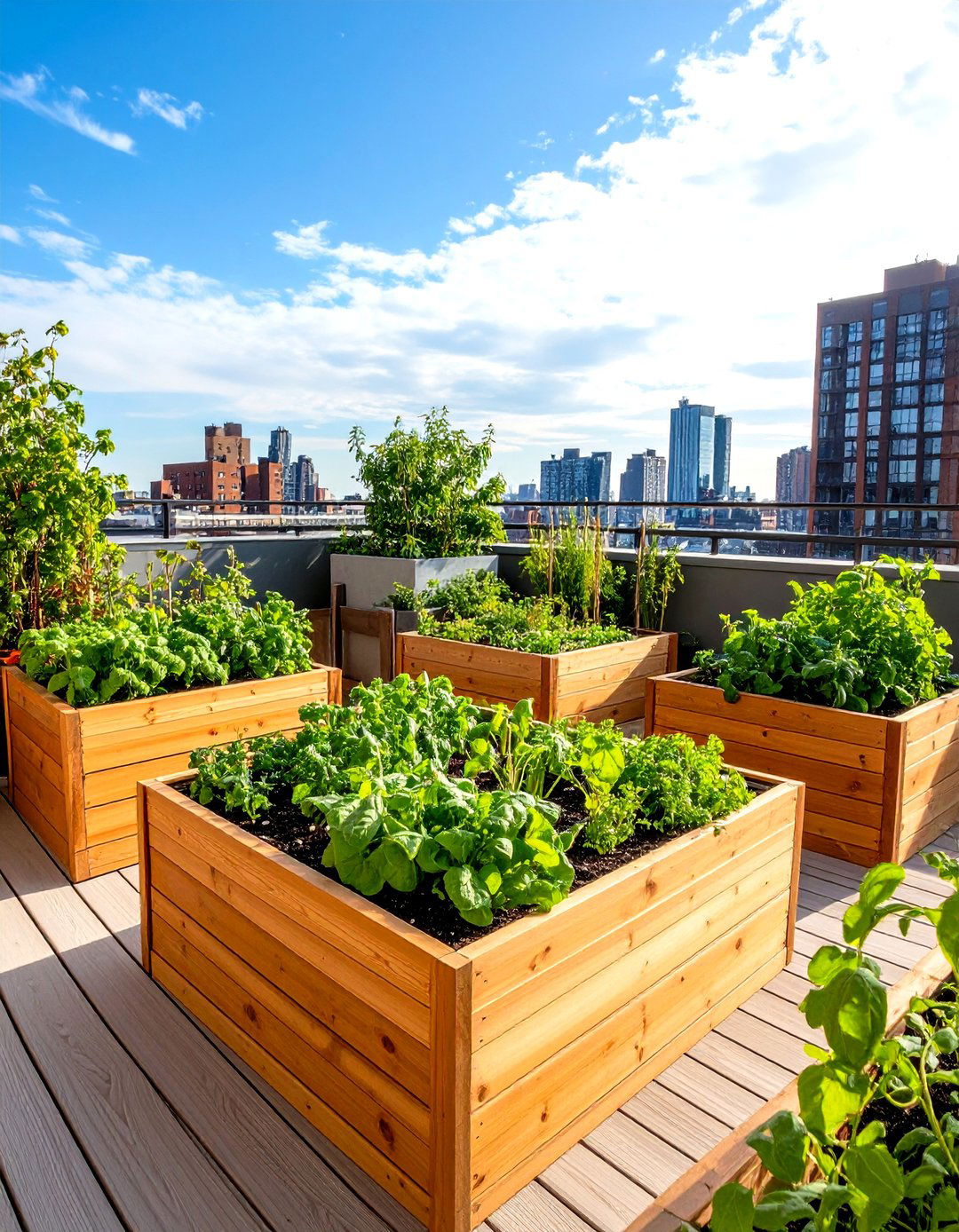
An edible rooftop garden transforms underutilized space into a productive food source by growing vegetables and herbs in containers or raised beds. Easy-to-manage crops like tomatoes, cucumbers, okra and chillies thrive in sunny, well-drained microclimates, yielding fresh produce for home cooks. Inspired by chef Danielle Chang’s SoHo penthouse garden, cultivating Asian greens and herbs such as bok choy, cilantro and Thai basil ensures year-round harvests for diverse cuisines. Incorporate lightweight planters and proper staking to support vine crops, and rotate seasonal plantings to maintain soil health. With edible varieties, your rooftop garden not only provides fresh ingredients, but also fosters a deeper connection to the food you eat.
10. Incorporating Water Features into Rooftop Garden Design

Incorporating a water feature transforms a rooftop garden into a tranquil retreat while managing rainwater and ambient temperature. Whether a small reflecting pool, fountain or cascading wall, these features can collect and recirculate stormwater through concealed reservoirs, reducing irrigation needs and easing roof drainage. Houzz experts recommend pairing water elements with gravel pathways and planting succulents or grasses nearby to maintain a balanced microclimate and minimize splash onto plantings. The gentle sound of flowing water drowns urban noise, offering a sensory respite. Strategically placed lighting can highlight water textures at night, enhancing the mood and extending usability of your rooftop garden space.
11. Designing a Wild Urban Rooftop Garden Oasis
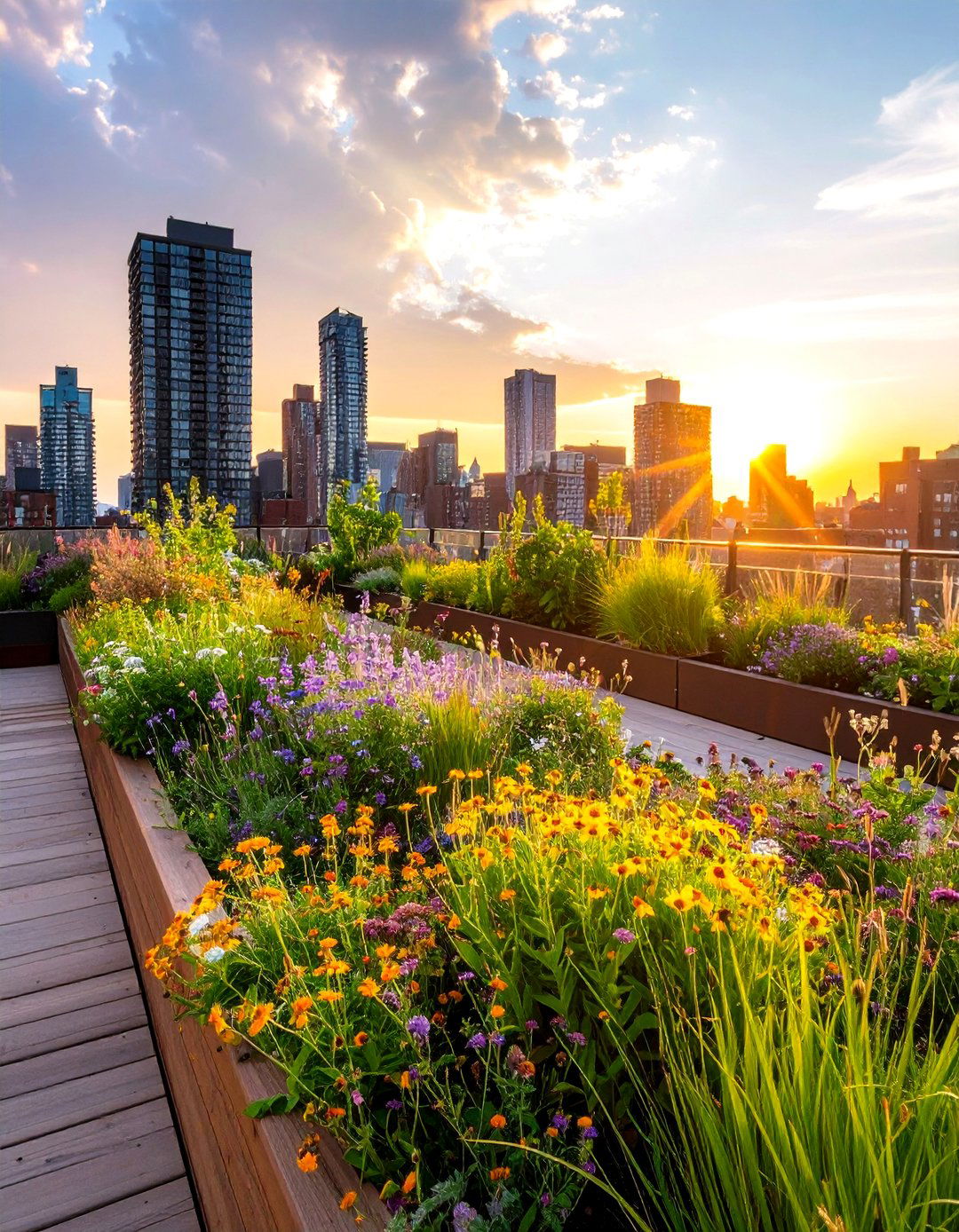
Designing a wild urban rooftop garden channels natural landscapes by combining native grasses, nectar-rich herbs, and hardy shrubs to support biodiversity in compact spaces. Belgian designers Bart Haverkamp and Pieter Croes emphasize selecting sun- and wind-tolerant plants like grasses and Mediterranean herbs, then layering them in loose clusters to mimic wild meadows on rooftops. Gardening Etc advises incorporating wildflower mixtures including poppies, cornflowers, and self-seeding annuals to enhance color and attract pollinators. This approach reduces maintenance by allowing plants to self-regulate growth cycles while fostering habitats for bees and butterflies. Over time, the rooftop garden evolves into a resilient urban oasis that brings authentic ecological richness above the city skyline.
12. Pollinator-Friendly Flower Beds for a Rooftop Garden
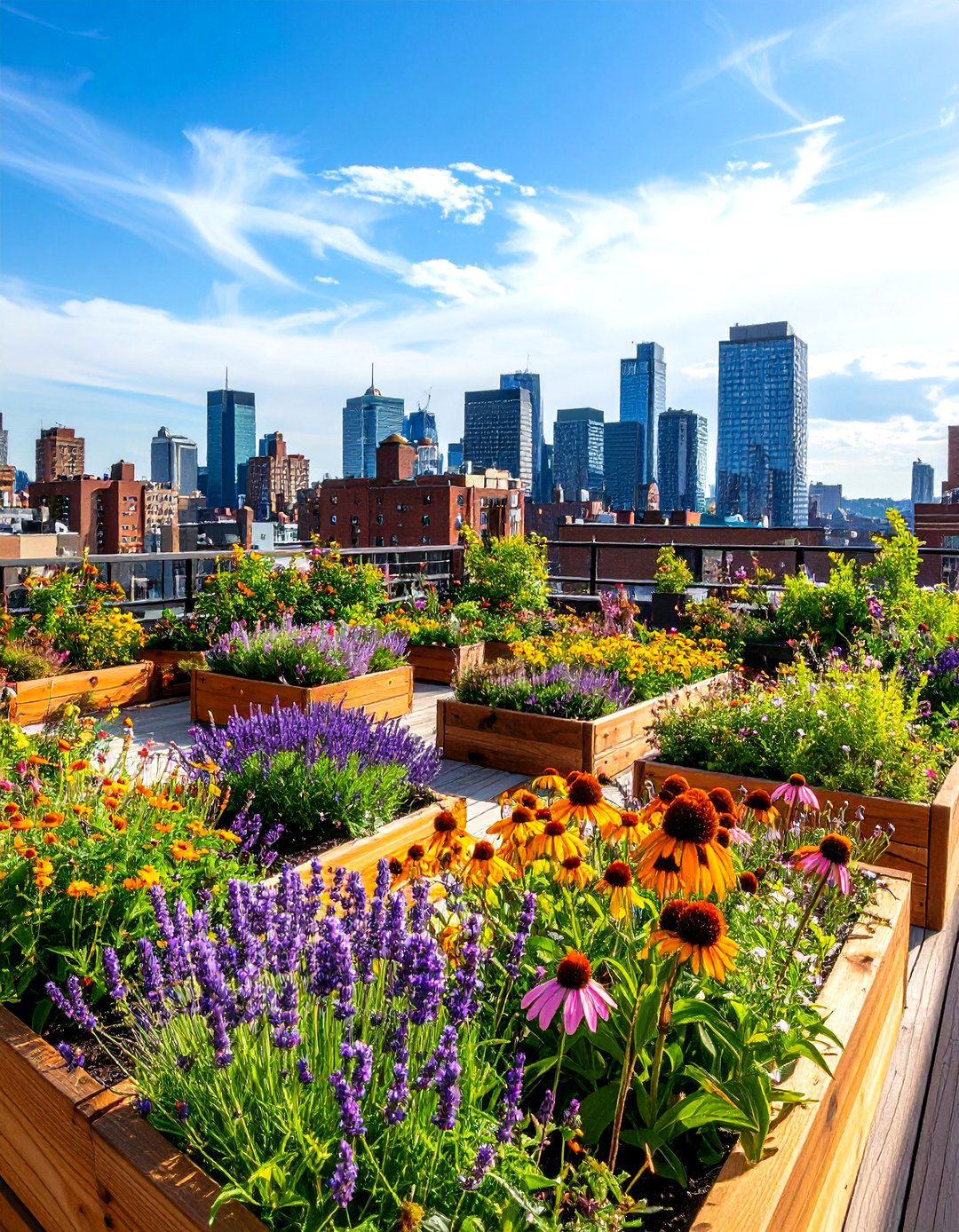
Crafting pollinator-friendly flower beds in a rooftop garden attracts beneficial insects and enriches urban ecosystems. Green roof installations planted with flowering species like lavender, echinacea and Rudbeckia provide nectar and pollen throughout the season, supporting bumblebees, solitary bees and hoverflies. Gardens Illustrated notes that sedum and mixed plant roofs host invertebrates and insects, improving biodiversity and creating habitats on high-rise structures. Positioning flowers in clusters and staggering bloom times enhances foraging efficiency, while installing shallow water dishes offers hydration sources. By prioritizing pollinator habitat in your rooftop garden design, you boost local biodiversity and contribute to healthier urban green networks.
13. Fire-Resistant Plant Choices for Rooftop Garden Safety

In wildfire-prone regions, designing a fire-resistant rooftop garden focuses on plants with high moisture content and minimal flammable material. Succulents like white stonecrop (Sedum album), goldmoss stonecrop (Sedum acre) and calcareous houseleek (Sempervivum calcareum) retain water in fleshy leaves and resist ignition, creating living shields across a rooftop garden. These species thrive without irrigation and require little maintenance once established. Incorporating nonflammable hardscape elements such as stone pathways and gravel mulches further interrupts fuel continuity. When selecting additional species, avoid plants with papery bark or volatile oils. Combining these fire-safe strategies enhances both the safety and resilience of rooftop garden installations in high-risk areas.
14. Rainwater Harvesting Systems for Rooftop Garden Sustainability
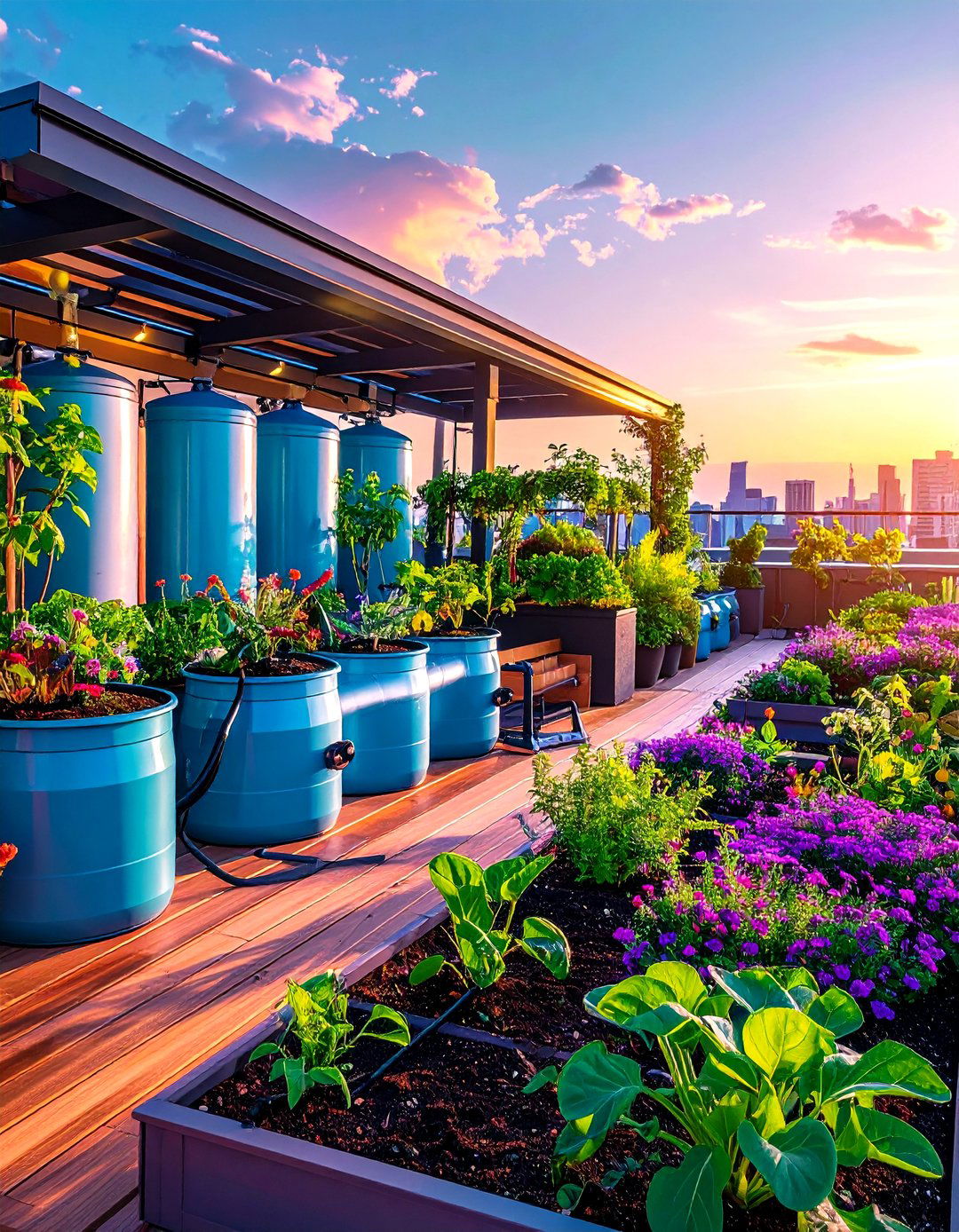
Incorporating rainwater harvesting into a rooftop garden design turns precipitation into a valuable resource, reducing irrigation demands and easing stormwater runoff. The historic Lazarus Building rooftop collects rainwater through a built-in gutter system, stores it in hidden tanks and routes it back into planters across the garden, creating a closed-loop green infrastructure. Green roofs naturally retain a significant portion of rainfall, moderating discharge into urban drainage networks and filtering pollutants before release. Installing rain barrels or cisterns under planting modules and integrating drip irrigation ensures efficient water distribution. This strategy supports sustainable rooftop garden maintenance while promoting environmental stewardship in dense cities.
15. Modular Trays and Pocket Planters in Rooftop Garden Layouts
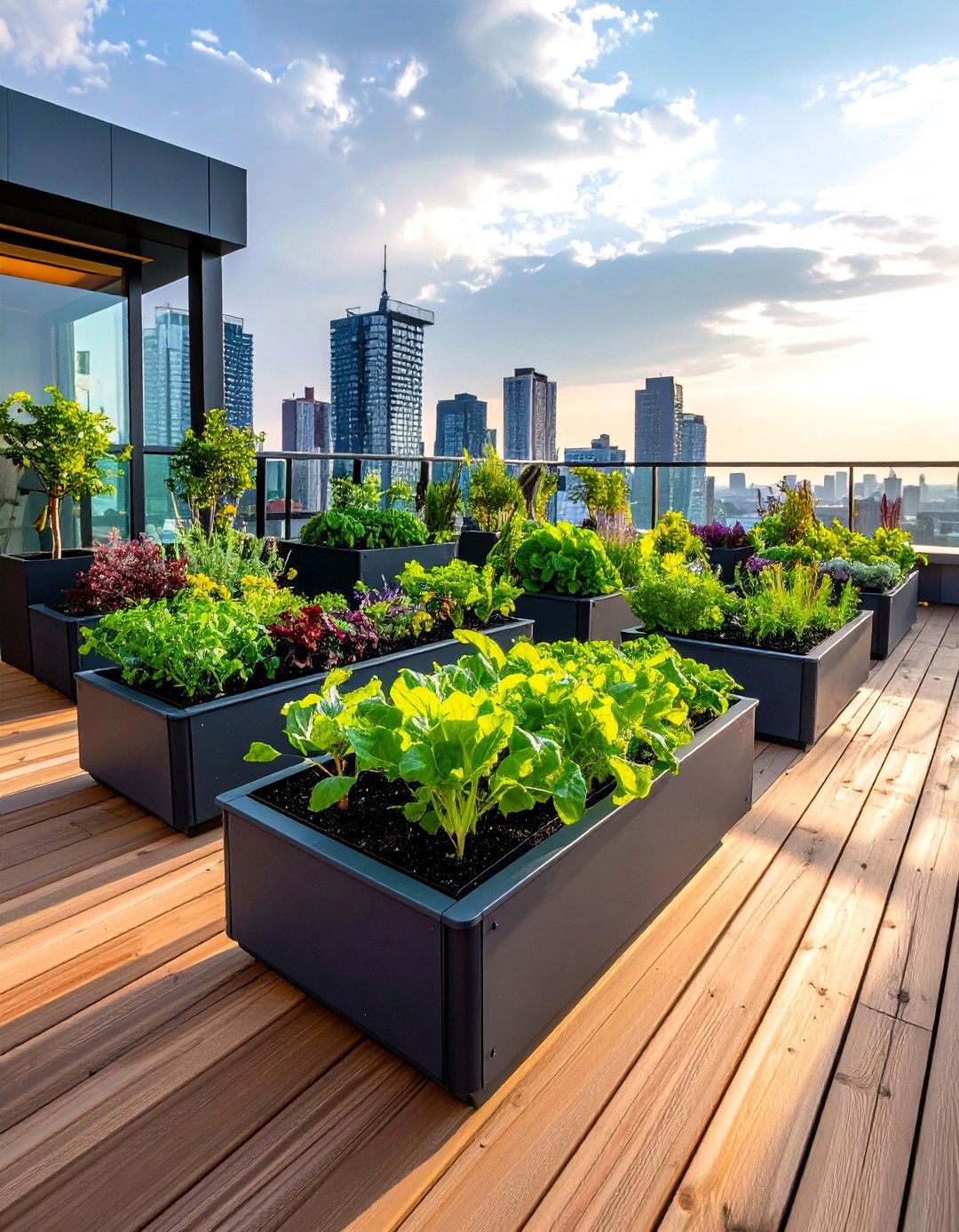
Modular tray and pocket planter systems allow flexibility and creativity in a rooftop garden by offering interchangeable planting modules that can be repositioned as needs change. Tube planters—rows of PVC or plastic troughs—can be arranged horizontally to form meadow-like borders, while pocket planters such as Woolly Pockets mount directly to walls, providing individual planting pockets for herbs and small flowers. These lightweight solutions distribute weight evenly and enable vertical stacking to maximize space. Their modularity eases seasonal rotation and simplifies soil replenishment. By employing diverse modules, rooftop gardeners craft dynamic layouts that evolve over time without requiring permanent installations.
16. Dwarf Fruit Trees for a Charming Rooftop Garden Orchard
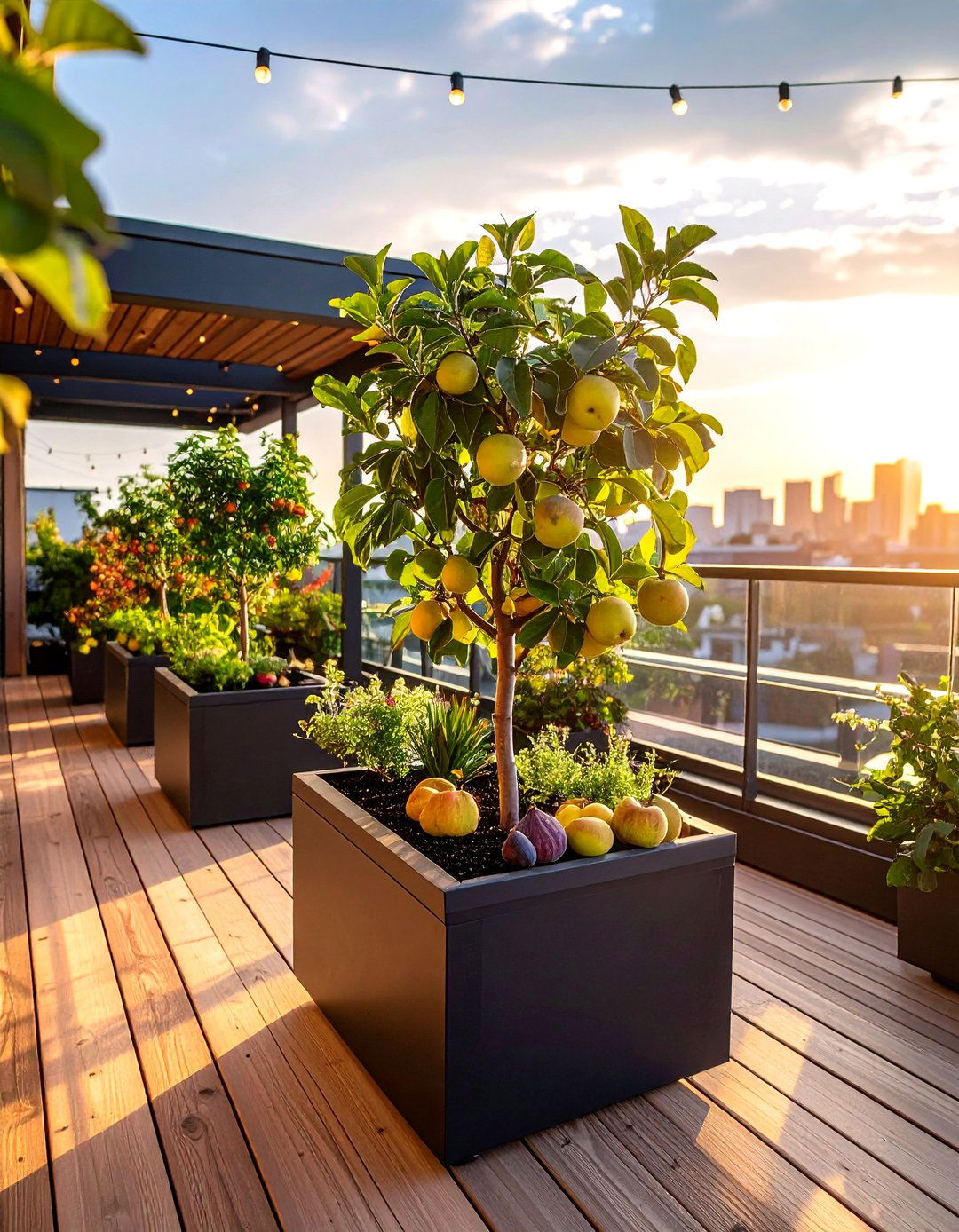
Dwarf fruit trees bring the charm of a mini orchard to a rooftop garden without excessive weight or space demands. Selecting compact varieties such as semi-dwarf mango ‘Ice Cream’, fig trees, or espaliered apple and peach trees allows harvesting fresh fruit while keeping canopy heights under 6 ft, ideal for container culture. Planting in large pots with nutrient-rich, well-draining soil and providing winter protection ensures successful fruiting cycles. Pairing fruit trees with ornamental flowers or ground-cover herbs adds visual interest and maximizes productivity. Regular pruning maintains structure and encourages air circulation, helping rooftop gardeners reap bountiful harvests year after year.
17. Native Wildflower Green Roof Elements in a Rooftop Garden
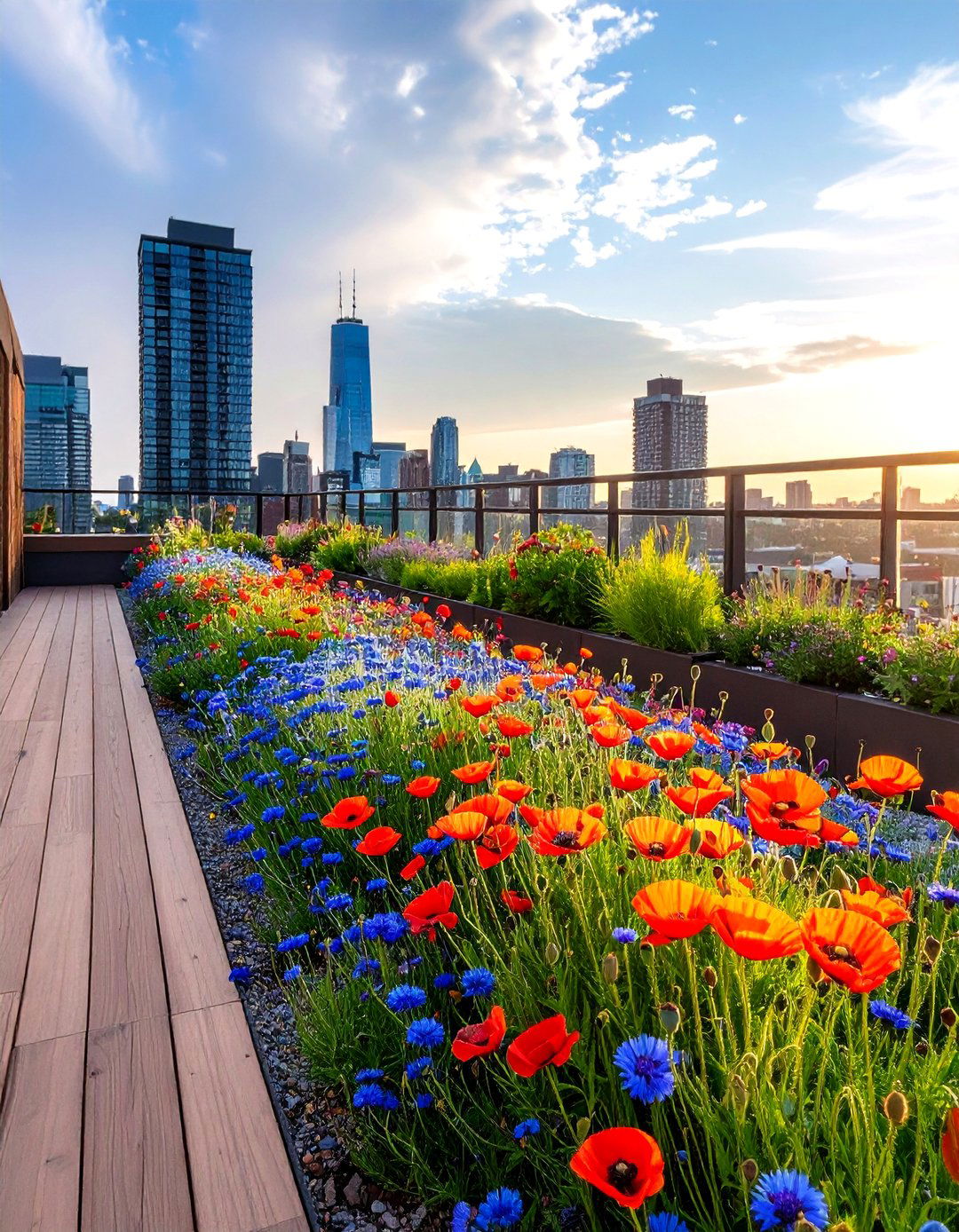
Incorporating native wildflower meadow strips on a rooftop garden creates seasonal blooms while supporting local ecosystems. Popular seed mixes include cornflower, poppy, oxeye daisy and native grasses, which establish quickly in lightweight substrates and self-seed for successive years. Landscape designer boards on Pinterest highlight vibrant combinations of wildflowers and ornamental grasses that soften hardscape edges and attract butterflies. Planting in shallow trays with well-draining soil and minimal organic matter mimics native conditions, encouraging flora to flourish with little maintenance. This strategy transforms modular rooftop garden sections into living tapestries, integrating natural beauty and biodiversity high above the urban core.
18. Ambient Lighting Zones to Enhance Rooftop Garden Atmosphere
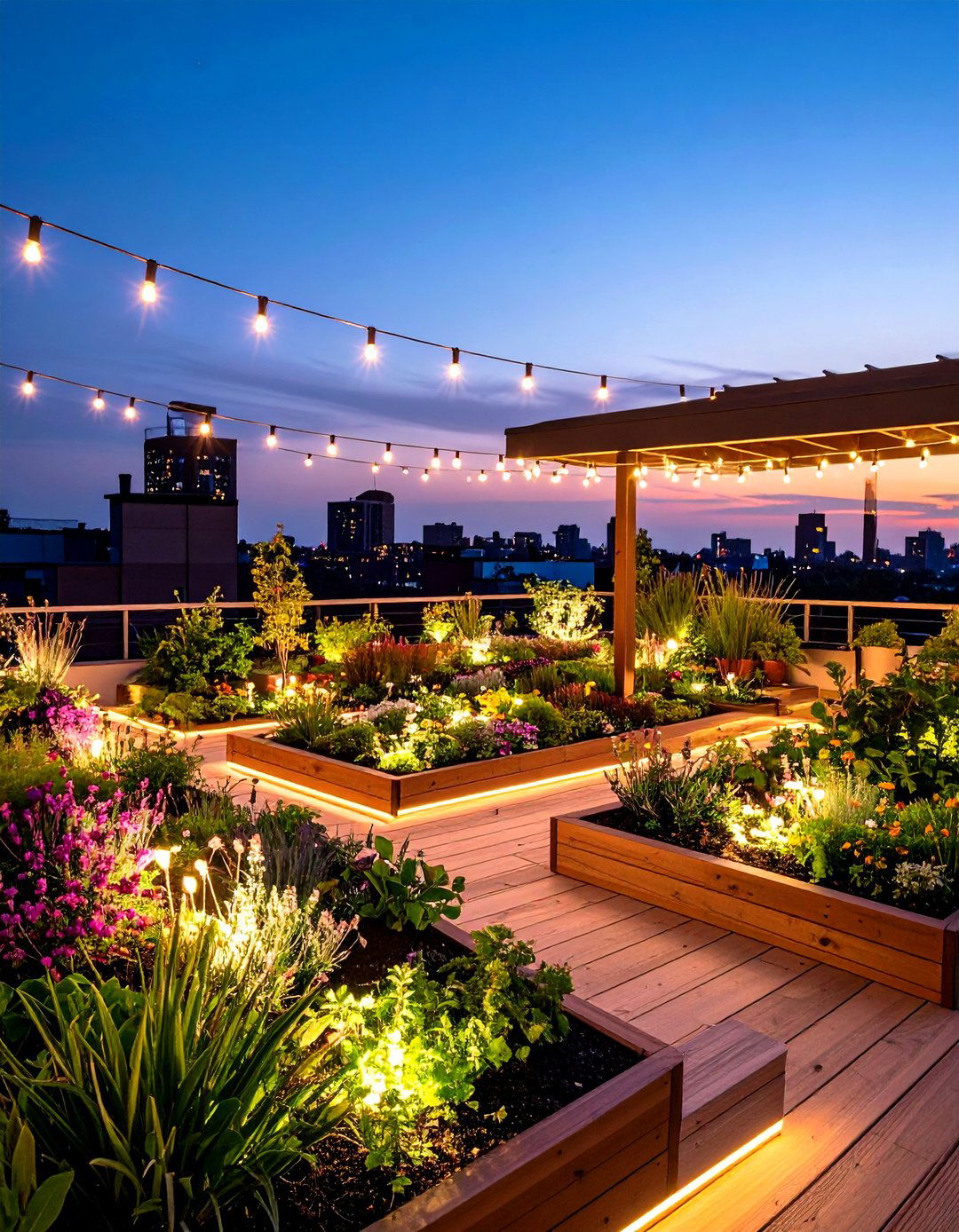
Ambient lighting transforms a rooftop garden into a welcoming evening escape, extending its usability after sunset. Layered illumination—combining LED strip lights along pathways, solar-powered string lights draped across pergolas, and recessed uplighting around planters—creates depth and mood. Incorporating portable fire tables or chimineas adds both warmth and flickering glow, offering a gathering point in cooler months. Jessica Damiano advises strategic fixture placement to highlight key features without overpowering greenery. Dimmer controls and timers help manage energy use and adjust ambiance seamlessly. Well-planned lighting enhances safety, emphasizes the beauty of plant textures, and ensures your rooftop garden shines long after daylight fades.
19. Establishing a Yoga Retreat in Your Rooftop Garden
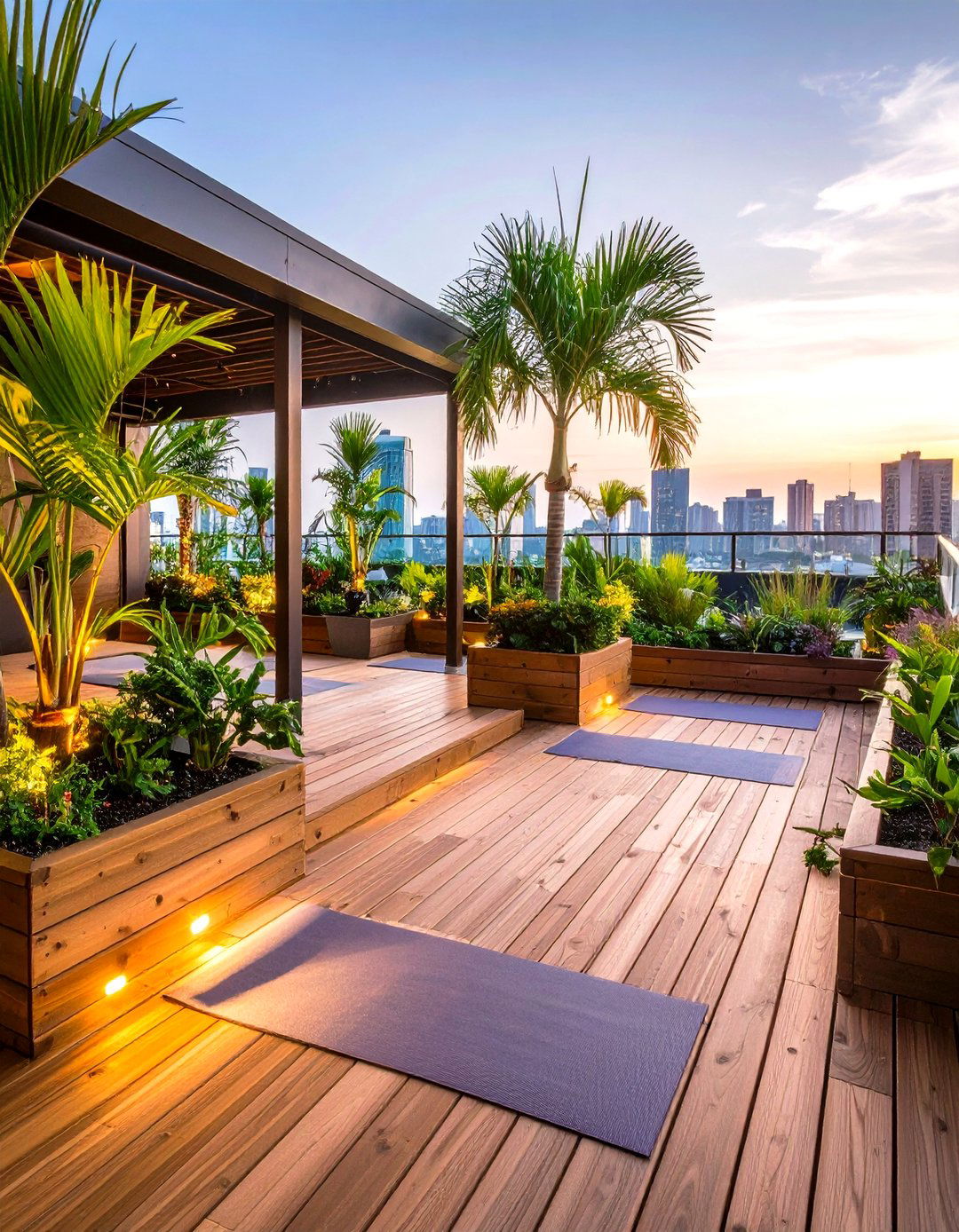
Creating a dedicated yoga and meditation corner within a rooftop garden enhances wellness by offering a calm, green sanctuary high above street noise. Incorporate a level decking area furnished with weather-resistant yoga mats or cushions, flanked by tall potted palms or bamboo for natural privacy and shade. Bonnie Plants demonstrates that combining raised beds and lounge furniture can define functional zones without sacrificing greenery. Adding a vertical living wall nearby supplies a fresh, humid backdrop, while soft outdoor rugs delineate the practice space. This fusion of hardscaping and plants creates a balanced environment where rooftop garden enthusiasts can unwind, stretch, and breathe deeply amid lush surroundings.
20. Hanging Garden and Green Wall Systems for a Rooftop Garden
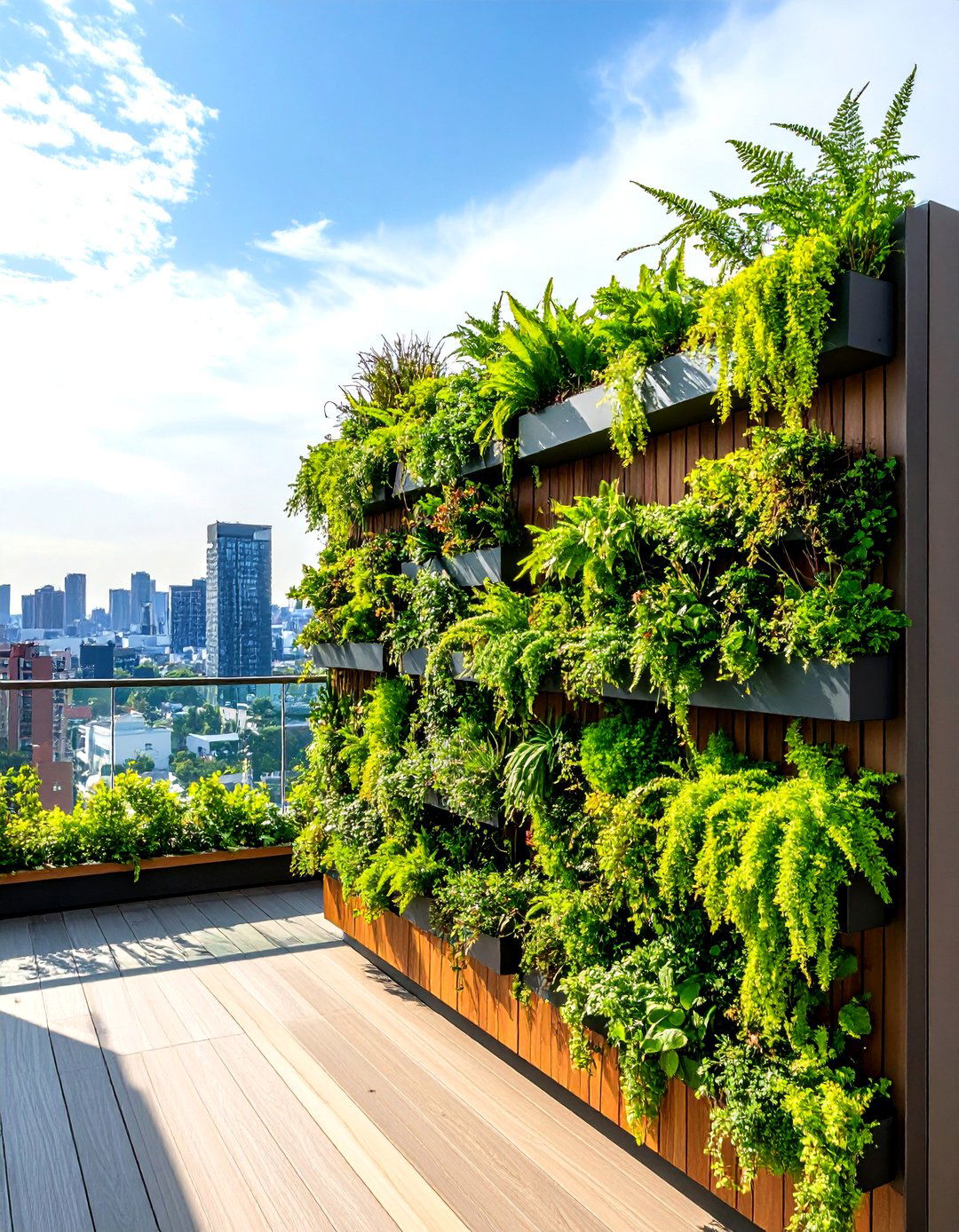
Hanging systems and green wall panels transform vertical surfaces into living tapestries, adding height and drama to a rooftop garden. Prefabricated modular wall gardens feature individual planting modules arranged in grid patterns to support ferns, mosses and small flowering plants, while hanging baskets on metal screens offer trailing vines and hanging blooms. Proper waterproof membranes and lightweight growing media protect the roof deck from moisture and excessive weight. Built-in drip irrigation keeps plants healthy with minimal intervention. By varying plant selection and arrangement, each green wall panel can reflect seasonal shifts, offering rooftop garden observers a dynamic, living artwork that evolves across the seasons.
Conclusion:
By weaving together sustainable green roofs, modular planters, edible landscapes and ambient design, rooftop garden ideas unlock the potential of overlooked urban spaces. Each concept—whether a sedum mat that cools buildings or a dynamic green wall—contributes to environmental resilience, biodiversity and human well-being. Embracing these ideas can transform any rooftop into a multifunctional oasis that feeds the body, calms the mind and nurtures the planet. Now it’s your turn to bring these rooftop garden ideas to life.


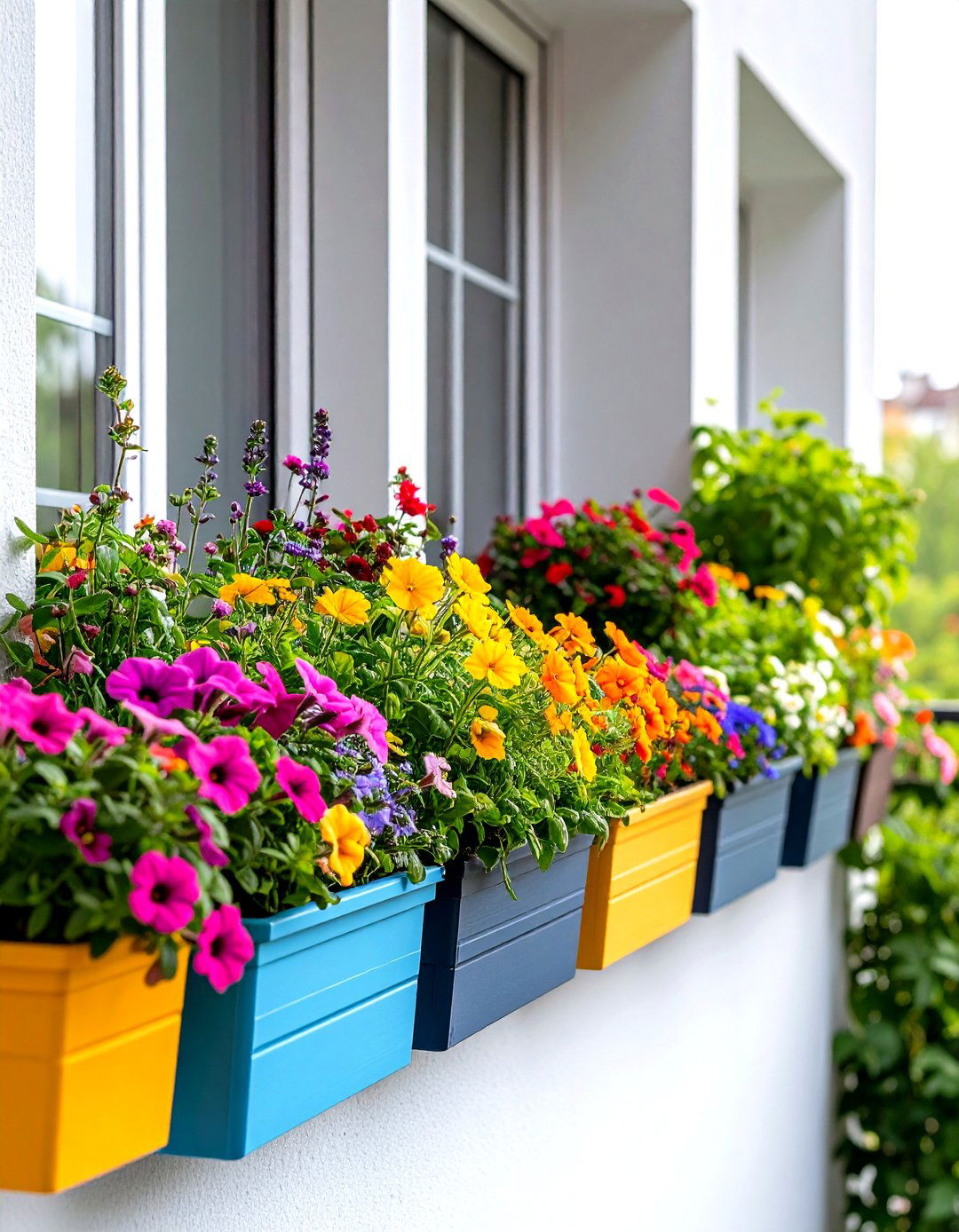
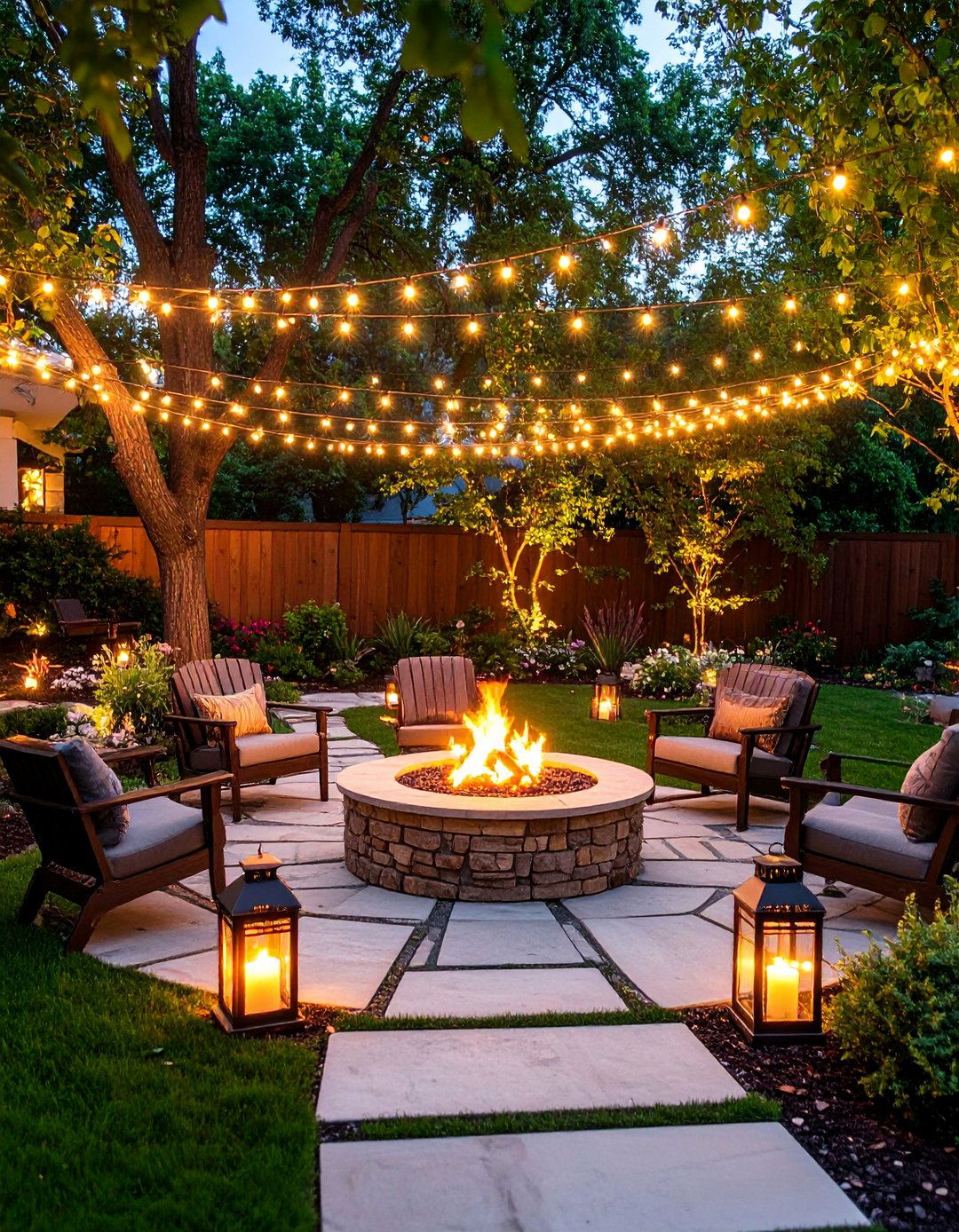
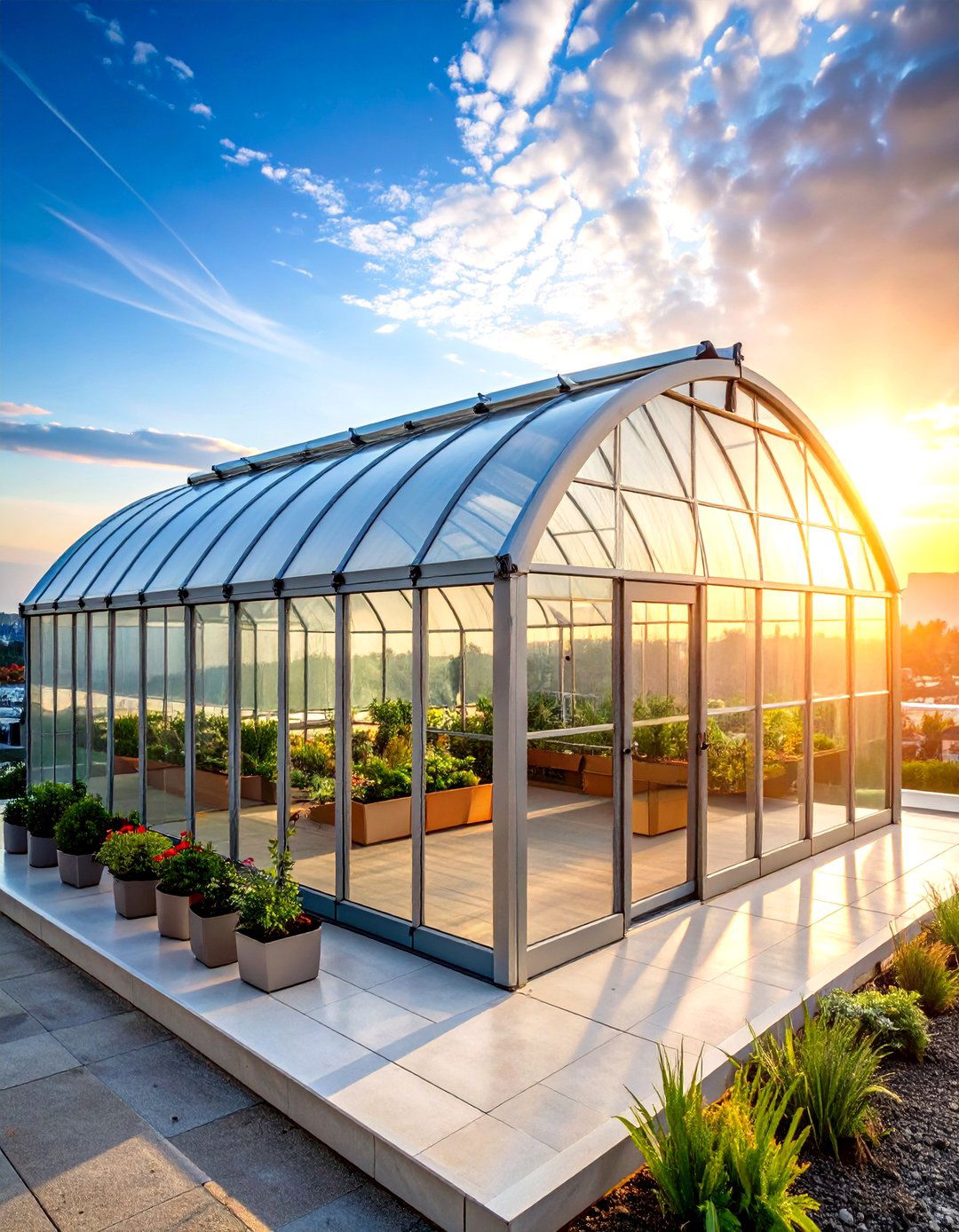

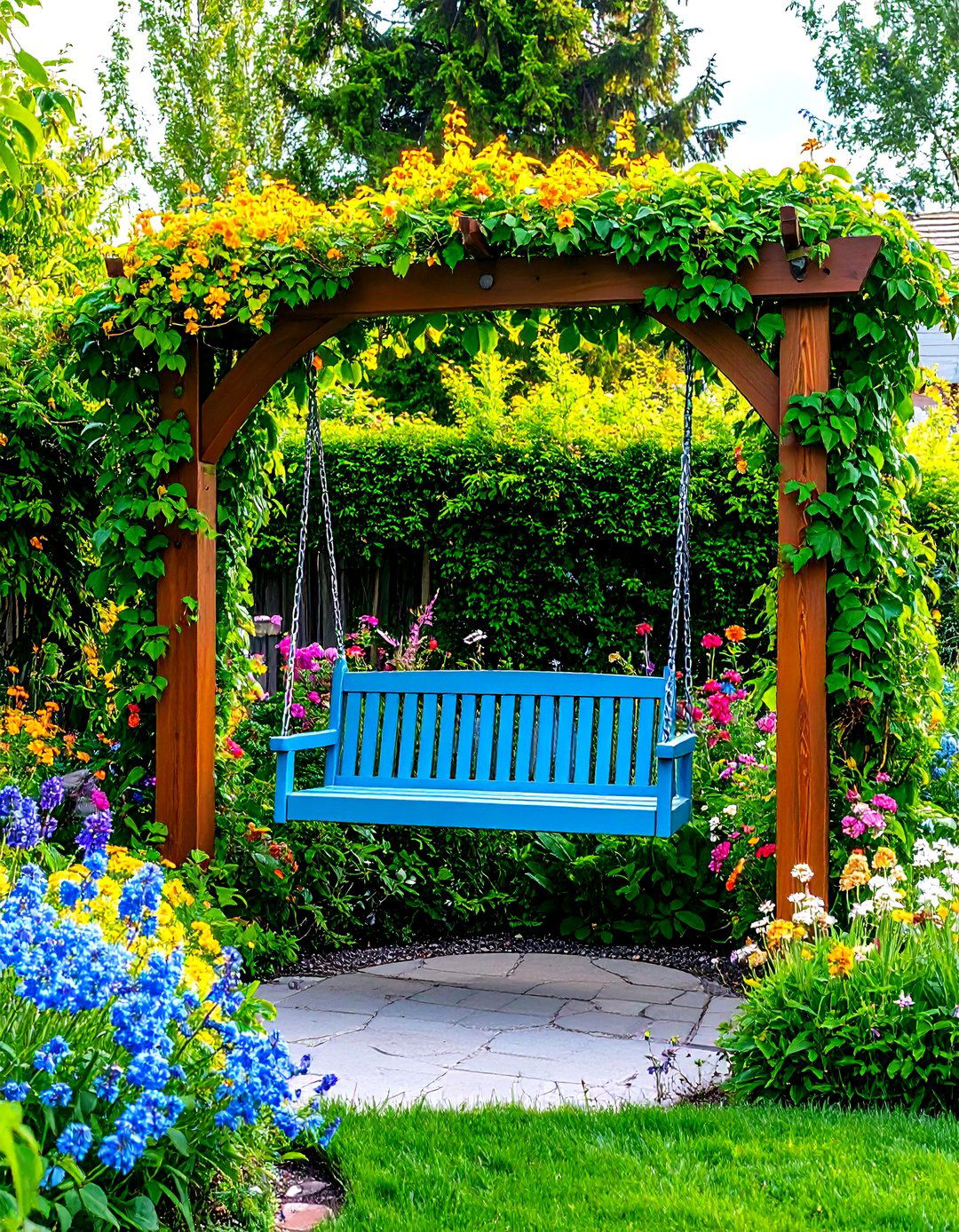


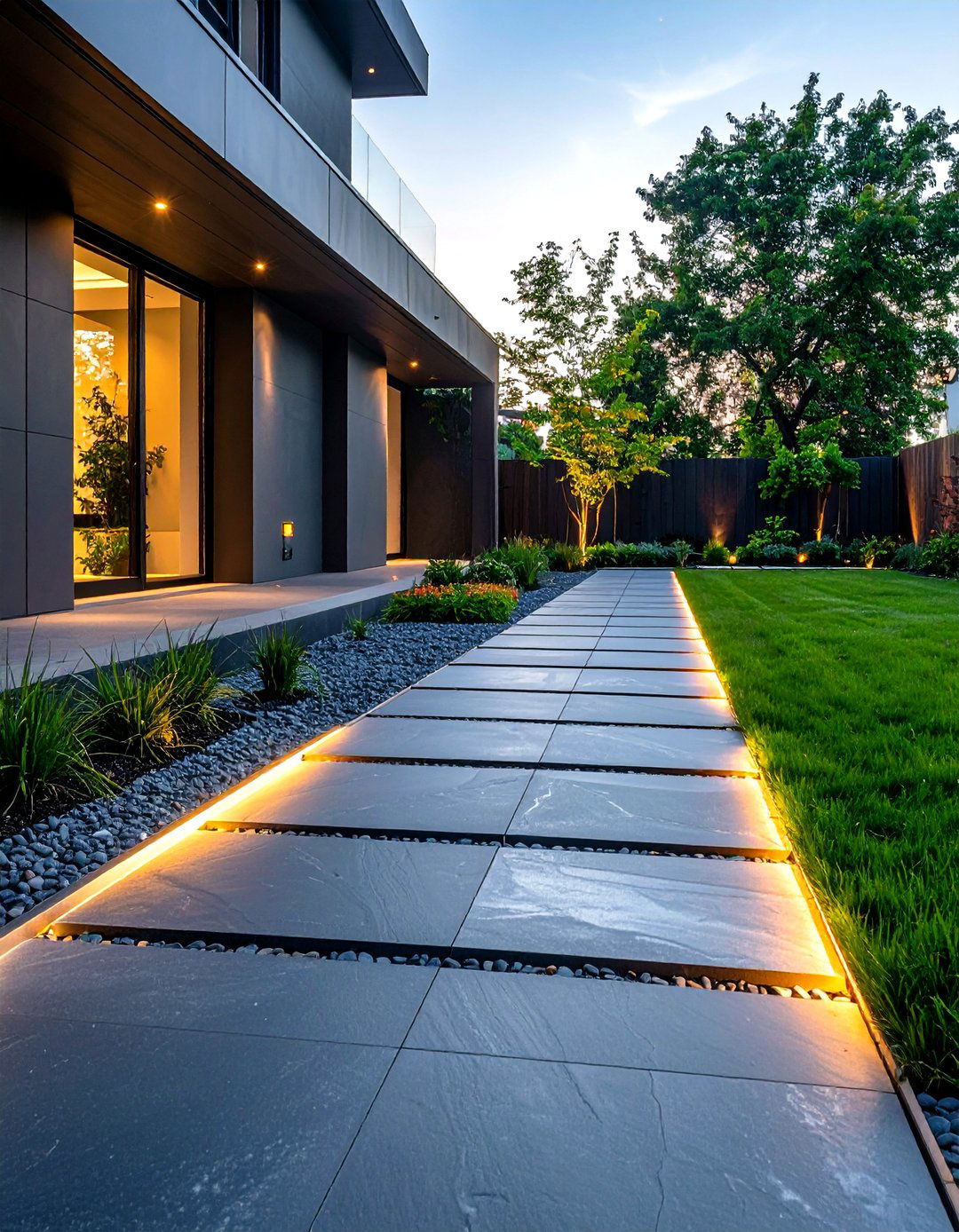
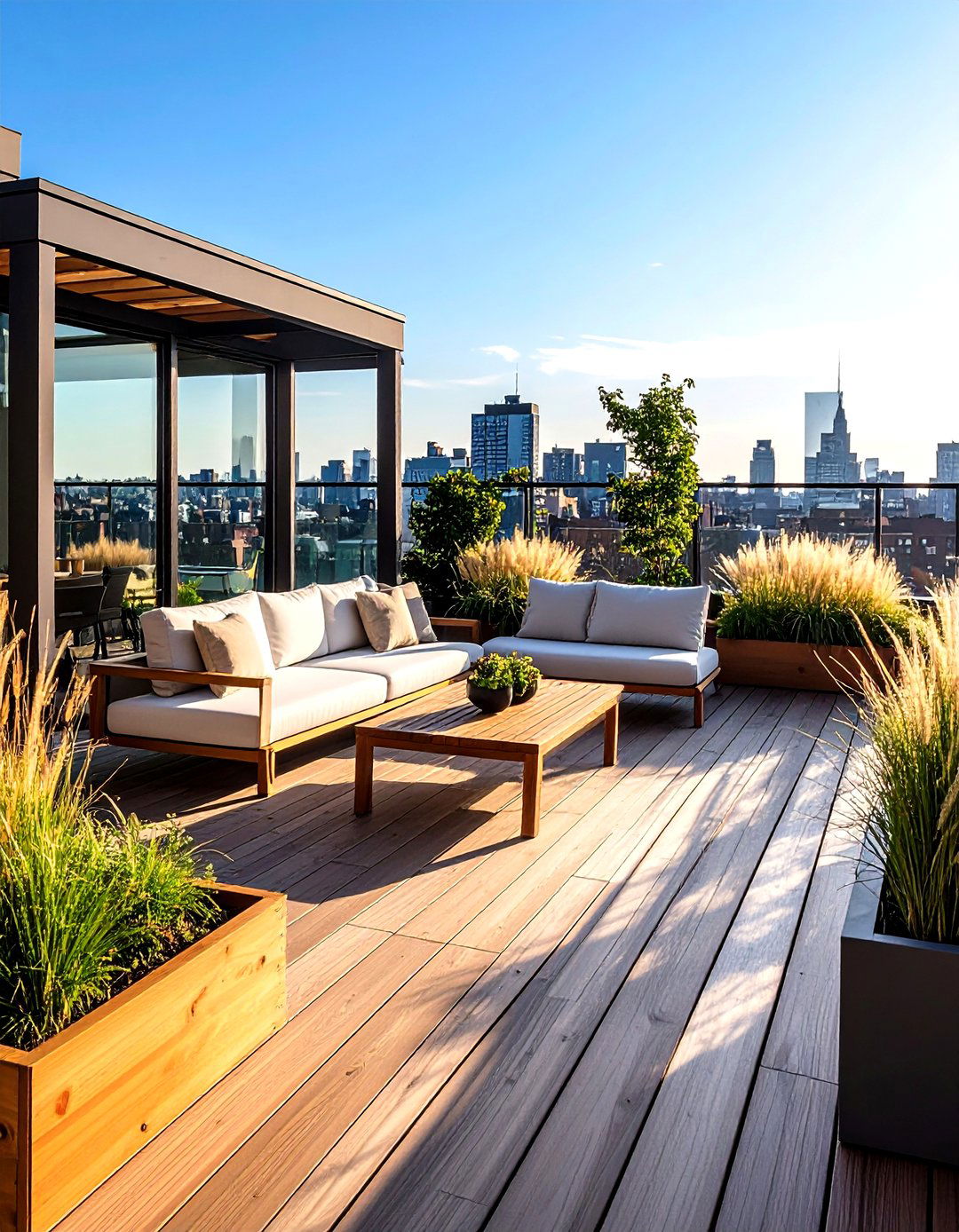

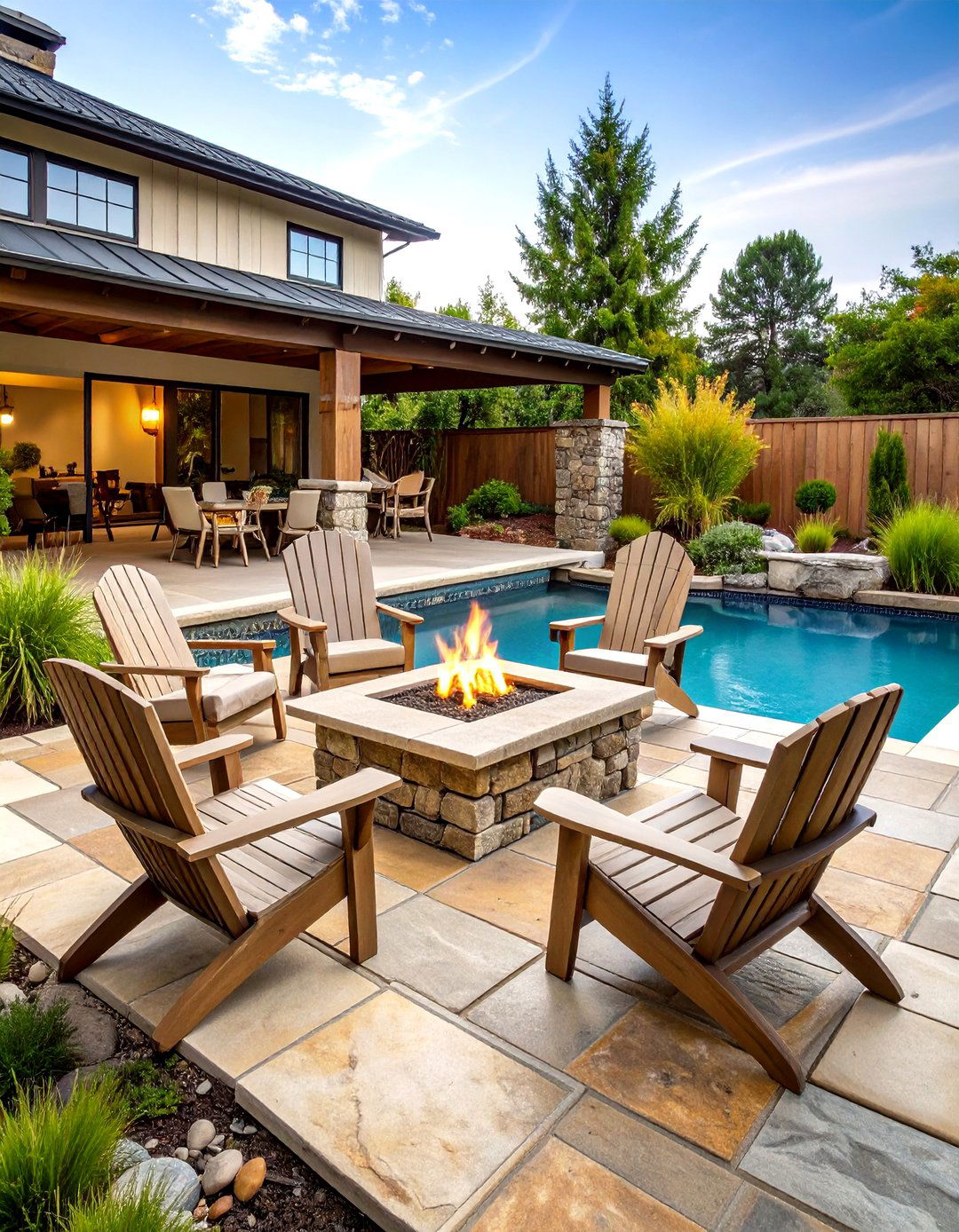
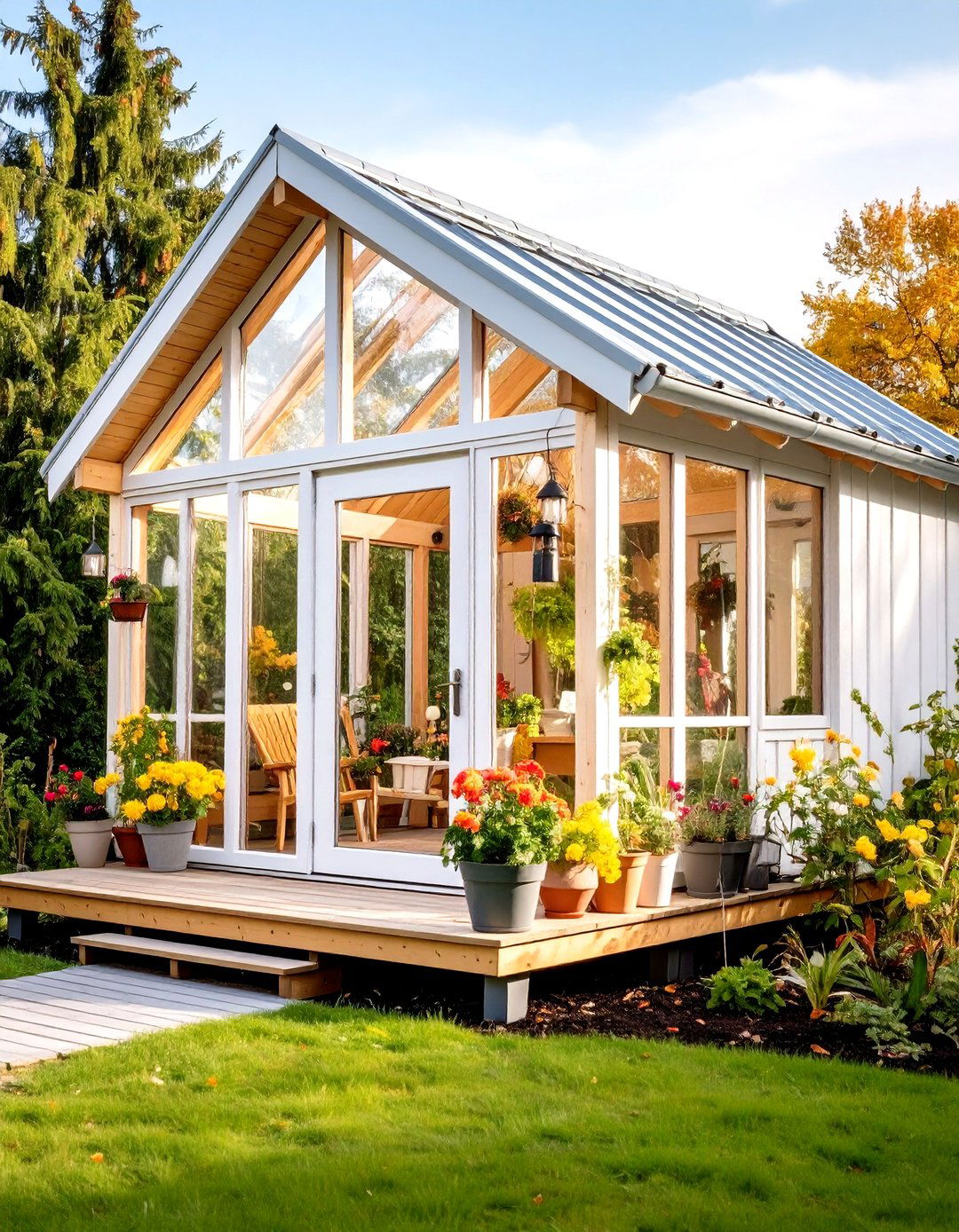


Leave a Reply